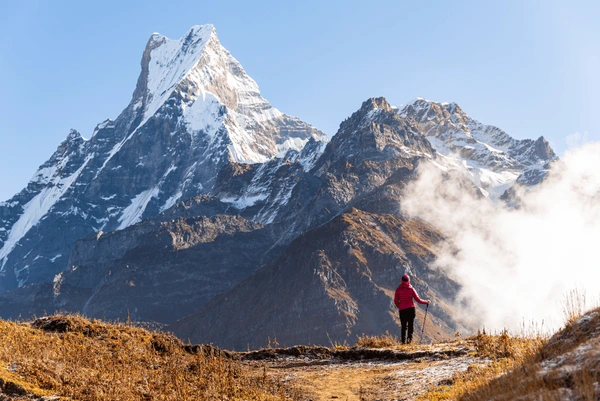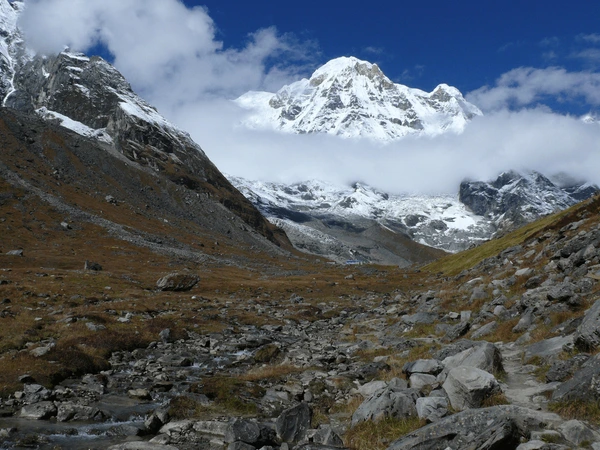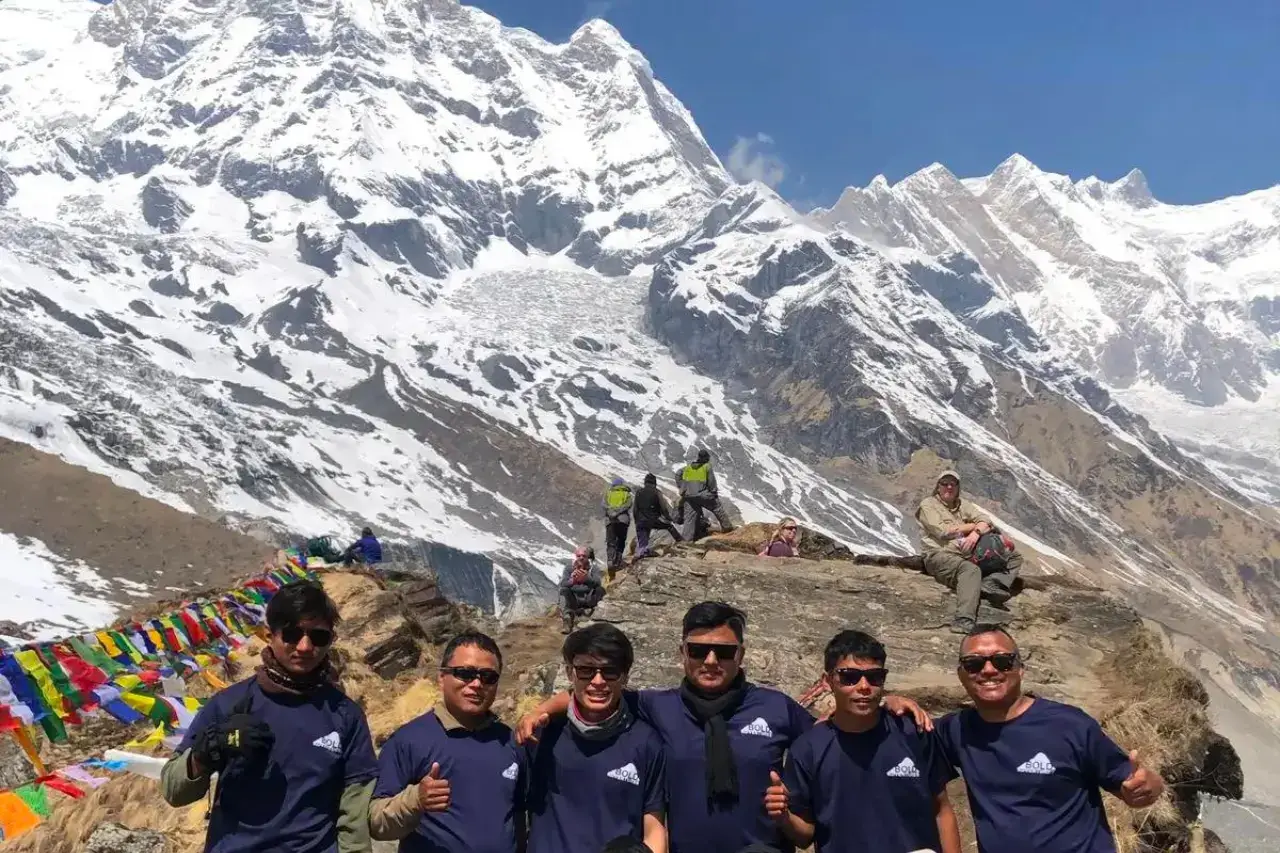Imagine yourself standing amidst the grandeur of the Himalayas, surrounded by awe-inspiring peaks providing an absolute heavenly feeling. The Annapurna Base Camp Trek, a cherished dream of trekking enthusiasts, offers you a ticket to this breathtaking realm.
Throughout the trek, the trail takes you through a tapestry of landscapes, from verdant rhododendron forests to picturesque traditional villages, all leading to the crown jewel – the base camp of the mighty Annapurna mountain range. But before you lace up your hiking boots, it is essential to understand the Annapurna Base Camp trek permits that safeguard the pristine beauty of the Annapurna region. In this guide, we will explore the details of the Annapurna Base Camp Trek permits to equip you with the knowledge to navigate the permit process seamlessly.
Annapurna Base Camp Trek Permit Details

The Annapurna trekking permits are essential for ensuring the preservation of the region’s natural beauty, supporting conservation efforts, and maintaining the sustainability of the trekking routes. Moreover, the Annapurna Base camp trek permits also ensure the safety and security of trekkers by facilitating effective monitoring and rescue operations.
Annapurna Base Camp trek permits include several types of permits. Each permit serves a specific purpose, addressing environmental concerns, promoting responsible tourism practices, and contributing to the well-being of the local communities. Understanding the Annapurna base camp trek permit and acquiring them in advance will ensure compliance with the regulations and allow you to fully immerse yourself in the wonders of the Annapurna region, knowing that you are trekking respectfully and responsibly.
Permits Required In Annapurna Base Camp Trek
So, what are the different types of Annapurna trekking permits that you are required to obtain before embarking on the trek? Let’s find out.
Annapurna Conservation Area Project (ACAP) Permit
Annapurna Conservation Area Project (ACAP) Permit is the most popular and vital permit under the Annapurna Base camp permit requirements. This permit is required for trekking in the entire Annapurna region, no matter the days of your trekking. With this single permit, you can access all parts of the Annapurna region and explore all of its diverse landscapes, captivating villages, and breathtaking mountain vistas without requiring additional payments.
You can obtain the ACAP permit in the Tourism Board of Nepal – Kathmandu or in the gateway to the Annapurna region – Pokhara. The fee that you pay for the Annapurna base camp trek permit is utilized for the conservation and sustainable development of the area, supporting initiatives aimed at preserving the natural environment and promoting eco-friendly practices.
After obtaining the ACAP permit, you can embark on the journey to explore the stunning Annapurna region, knowing that you have fulfilled your responsibility as a responsible traveler. The ACAP permit ensures that you can explore its wonders with ease and peace of mind, no matter which route (the classic Annapurna Circuit trek, the Annapurna Base Camp trek, or any other route within the Annapurna region) you choose for the trek.
Why Was ACAP Issued?
The Annapurna region spans an impressive 7,629 square kilometers and includes a wide range of ecosystems, from lowland subtropical forests to alpine meadows. Within the area, thousands of species of flora and fauna reside, including rare and endangered ones. The Annapurna Base Camp trek permit was introduced for the conservation and sustainability of the remarkable biodiversity in the Annapurna region.
Due to the high flow of trekkers, the Annapurna region faces various threats, such as unsustainable tourism practices, deforestation, and the degradation of natural habitats. The Annapurna Conservation Area Project Permit plays an important role in minimizing and preventing those threats by promoting eco-friendly practices, regulating the trekker’s activities, and raising awareness about the importance of responsible tourism. Moreover, the Annapurna region is home to several indigenous communities, each with its unique traditions, language, and way of life. ACAP is also aimed to promote and protect the rich cultural heritage of these communities. It ensures that the unique traditions and culture of the people living here are respected and preserved.
Terms And Conditions For The ACAP
Now, that we know the importance of ACAP for embarking on the Annapurna Base camp trekking trails, it is also essential to familiarize yourself with the terms and conditions associated with its usage. Let’s check on some of the key terms and conditions under the ACAP permit:
- The ACAP permit is a single-use permit. It means it is valid for one entry into the Annapurna region and becomes invalid once you exit the region.
- The ACAP permit grants access to specific designated areas within the Annapurna region. It is essential to understand and respect the boundaries of the permitted areas and you should not go beyond the designated areas in the permit.
- The ACAP permit is non-refundable and non-transferable. You can not refund it or transfer it to another person after obtaining the permit.
- It is mandatory to carry your ACAP permit with you at all times during your trek. And, you should be able to present it at the checkpoints along the trekking routes.
- During the trek, you must follow all rules and regulations set by the national park authorities.
Trekkers’ Information Management System (TIMS) Permit
In addition to the Annapurna Conservation Area Project permit, the Trekkers’ Information Management System (TIMS) Permit is another important Annapurna trekking permit required before embarking on the ABC trek. TIMS works as a centralized database of trekkers’ information which plays a vital role in managing trekker safety throughout their journey.
You can obtain the TIMS permit is available in two categories: Individual Trekkers and Organized Trekkers. Solo trekkers who do not come from a registered trekking agency fall under the Individual Trekkers category. And, the trekkers who are traveling with a registered trekking agency fall under the Organized Trekkers category. You can obtain the TIMS permit from either the Trekking Agencies Association of Nepal (TAAN) office in Kathmandu or through a registered trekking agency.
Why Was TIMS Issued?
The Trekkers’ Information Management System permit was introduced as an important Annapurna trekking permit with the aim to enhance trekker safety. By maintaining a centralized database of trekkers’ information, it enables authorities to swiftly locate and assist individuals in case of emergencies. This system facilitates search and rescue operations and enhances communication between trekkers, local communities, and authorities, thus promoting a safer trekking experience.
Additionally, the TIMS permit also allows for effective monitoring of trekking routes. By keeping track of the number and movement of trekkers, authorities can manage the flow of visitors to prevent overcrowding and ensure the sustainability of the trails.
Terms And Conditions For The TIMS
Obtaining the Trekkers’ Information Management System permit comes with certain terms and conditions that trekkers must adhere to. Let’s check on some of the key terms and conditions for the TIMS permit:
- The TIMS permit is valid for the specified trekking region and duration mentioned during the application. It is essential to ensure that the permit covers the entire trekking period to avoid any legal complications.
- You should carry your TIMS permit at all times during the trek. Upon check, you must present at various checkpoints along the trekking routes.
- Trekkers are expected to follow responsible trekking practices, including respecting local culture and customs, preserving the environment by adhering to waste management guidelines, and being mindful of the impact on local communities.
How Much To Pay For Annapurna Base Camp Trek Permits?

The Annapurna Base Camp Trek cost varies for different nationalities. Here we have compiled the list of Annapurna permit costs for Nepali, SAARC nationals, and Non-SAARC Nationals. Let’s check on them in detail.
Annapurna Conservation Area Project (ACAP) Permit Fee
- For Individual Trekkers
| Nationality | Cost |
| Nepali | NRs 200 |
| SAARC – countries | NRs 1000 |
| Non-SAARC countries | USD 30 |
- For Group Trekkers
| Nationality | Cost |
| Nepali | NRs 200 |
| SAARC – countries | NRs 1000 |
| Non-SAARC countries | USD 30 |
Trekkers’ Information Management System (TIMS) Permit Fee
- For Individual Trekkers
| Nationality | Cost |
| Nepali | NRS 200 |
| SAARC – countries | NRS 600 |
| Non-SAARC countries | USD 30 |
- For Group Trekkers
| Nationality | Cost |
| Nepali | NRS 200 |
| SAARC – countries | NRS 300 |
| Non-SAARC countries | USD 10 |
Also, check out:
Requirements to Apply for the Annapurna Base Camp Trek Permits
To obtain the necessary permits for the Annapurna Base Camp Trek, you are required to fulfill certain requirements and provide specific documents. Make sure you meet the following requirements before applying for Annapurna Base Camp trek Permits:
- A valid passport with at least six months of validity remaining.
- 2 photocopies of passports
- Recent Passport-sized Photographs (4 copies)
- Permit fees for TIMS and ACAP
- TIMS Application form and ACAP application form
Conclusion
Both the Annapurna Base Camp Trek Permis – ACAP and TIMS are vital for a safe and enjoyable trekking experience. Bold Adventures, the best trekking agency in Nepal understands the importance of obtaining the required permits on time. Our dedicated team is here to guide you through the Annapurna base camp trek permit application process, ensuring a smooth and hassle-free experience. We will provide you with the necessary information, assist with the paperwork, and ensure that you have all the required permits before you embark on your Annapurna Base Camp Trek. Contact Bold Adventures Nepal today.
You Might Be Interested In:

